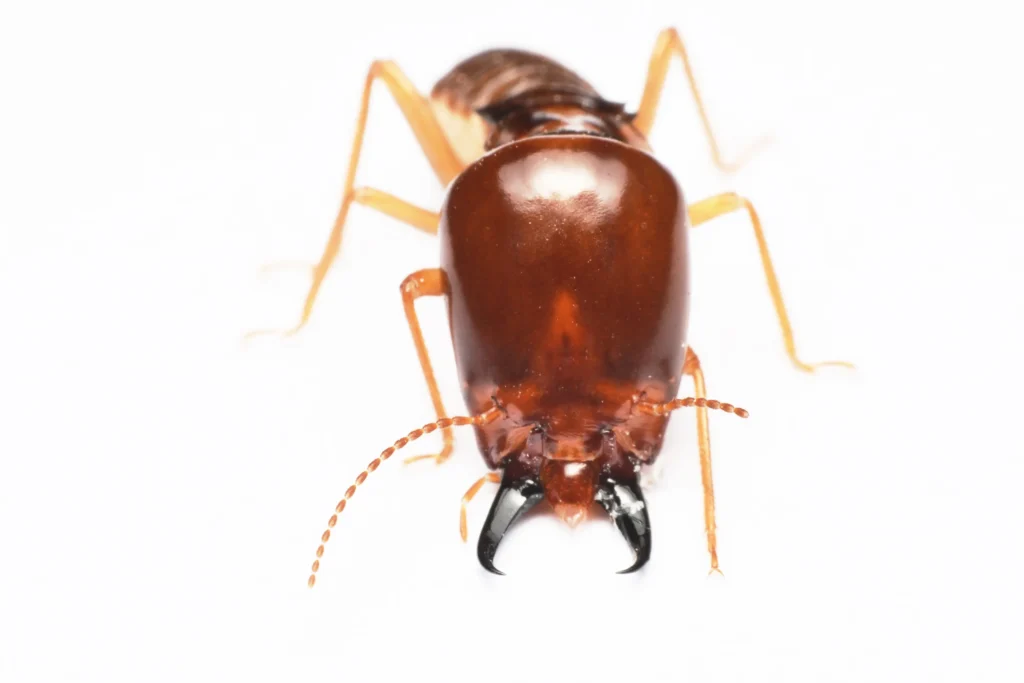



Ground Termite Treatments Hawaii.
Ground termites – another invasive species – do more damage in a shorter period of time than drywood termites. In fact, ground termites are labeled as one of the most economically devastating pests in our islands! These little buggers live underground, get their water for survival from moisture in the soil, and they never venture out for food. Ground termites don’t need to venture out for food because they get all the nourishment they need from your structural property; thus, their great ability to be very destructive very quickly. Many times, there will be no physical evidence of a ground termite infestation until their damage to a structure begins showing signs of distress (e.g., warped walls, wood that sounds hollow when tapped, collapsing floors, paint that looks discolored or is peeling, and perhaps even a leaking roof).
If our free inspection identifies a ground termite infestation, our recommendations for treatment may include a Sentricon® aboveground Elimination System, a Termidor® liquid barrier treatment, or an estimate for both. We all want a permanent solution to eliminating ground termites, so our recommendations include what will work best for you and the construction of your property.
Sentricon® Elimination System
Sentricon is an aboveground baiting system designed to eliminate entire colonies. Once eliminated, Sentricon is then guaranteed to keep ground termites away for as long as the bait stations remain in the ground on the property and are monitored regularly.
The cost for Sentricon installation and monitoring is based on perimeter linear footage of the structure being treated. Our estimate includes an initial installation and monitoring fee for the first year. Each year thereafter, we request an annual renewal fee for continued monitoring and servicing. Sentricon installation and recurring monitoring may be as low as $55.00 per month. Call us today to find out more.
Termidor®
Unlike Sentricon, Termidor is a liquid barrier treatment that – when applied properly by our certified professionals – begins working right away and provides complete elimination of termites that come in contact with the treatment. Termidor is a non-repellent liquid that ground termites can’t smell or taste. As such, the termites just ingest the liquid and share it with their colony, which eventually eliminates all of them.
Termidor liquid treatment upholds a kill rate of six times faster than other baiting systems on the market. This liquid barrier treatment will rid your home of ground termites for up to five years. The cost of a Termidor treatment is also based on perimeter linear footage of the structure.
Any ground termite treatment is an important balance of our personal feelings, costs, and the construction of the property being treated. At Aloha Termite & Pest Control, Inc., we are here to help you with ground termite identification, and the best possible treatment if needed. Give us a call today with any questions you may have.
Question & Answers
The first sign of a ground termite infestation will probably be the mud tubes that they build leading from their underground colonies to wood sources. These mud tubes are about the width of a pencil and just look like mud. Sometimes, the mud tubes will be easy to spot on concrete foundations or sides of the outside of the structure or in the garage. Most times, though, the mud tubes are a little hidden away in cracks in cement or wooden walls, behind baseboards, and underneath flooring. Swarmers may be a sign of infestation, but keep in mind, when it is swarming season all termites are attracted to light (like outdoor porch lights). So, swarming termites is not necessarily a sign of infestation. Hollow wood may be another sign of any kind of termite infestation.
Ground termites do a lot more damage to Hawaii properties (and more quickly) than do drywood termites. Their colonies range from 1.4-6.8 million termites. A study done by the National Pest Management Association documented that a colony of three million termites ate one foot of wood every two days! So, a mature ground termite colony can cause massive structural damage in less than a year.
It is important to understand that termites – while never looking for a specific home or property – forage year-round, and do so mostly underground. If you currently have a termite-free home, it can become infested by termite activity going on close by. The best recommendation for a termite-free home or property is a preventative termite control program. Contact your pest control specialist for more information on termite control programs.
Ground termites do a lot more damage to Hawaii properties (and more quickly) than do drywood termites. Their colonies range from 1.4-6.8 million termites. A study done by the National Pest Management Association documented that a colony of three million termites ate one foot of wood every two days! So, a mature ground termite colony can cause massive structural damage in less than a year.
Ground termites, also known as dampwood termites, prefer damp and decaying wood, while subterranean termites require soil contact for nesting. Ground termites are less common but can still cause significant damage to structures.
Ground termites typically enter homes and buildings through direct contact with damp or decaying wood. They are attracted to areas with high moisture levels, such as leaky roofs, gutters, or plumbing issues.
Signs of a ground termite infestation include finding small, round fecal pellets, hollow-sounding wood when tapped, and the presence of discarded wings near windows and doors.

